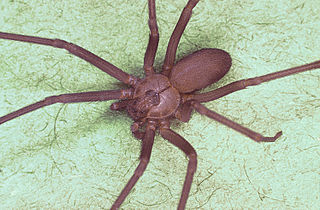
Arachnids are arthropods in the class Arachnida of the subphylum Chelicerata. Arachnida includes, among others, spiders, scorpions, ticks, mites, pseudoscorpions, harvestmen, camel spiders, whip spiders and vinegaroons.

Huntsman spiders, members of the family Sparassidae, catch their prey by hunting rather than in webs. They are also called giant crab spiders because of their size and appearance. Larger species sometimes are referred to as wood spiders, because of their preference for woody places. In southern Africa the genus Palystes are known as rain spiders or lizard-eating spiders. Commonly, they are confused with baboon spiders from the Mygalomorphae infraorder, which are not closely related.

Latrodectus is a broadly distributed genus of spiders with several species that are commonly known as the true widows. This group is composed of those often loosely called black widow spiders, brown widow spiders, and similar spiders. However, the diversity of species is much greater. A member of the family Theridiidae, this genus contains 34 species, which include several North American "black widows". Besides these, North America also has the red widow Latrodectus bishopi and the brown widow Latrodectus geometricus, which, in addition to North America, has a much wider geographic distribution. Elsewhere, others include the European black widow, the Australian redback spider and the closely related New Zealand katipō, several different species in Southern Africa that can be called button spiders, and the South American black-widow spiders. Species vary widely in size. In most cases, the females are dark-coloured and can be readily identified by reddish markings on the central underside (ventral) abdomen, which are often hourglass-shaped.

Lynx spider (Oxyopidae) is a family of araneomorph spiders first described by Tamerlan Thorell in 1870. Most species make little use of webs, instead spending their lives as hunting spiders on plants. Many species frequent flowers in particular, ambushing pollinators, much as crab spiders do. They tend to tolerate members of their own species more than most spiders do, and at least one species has been identified as exhibiting social behaviour.

Spitting spiders are a family of araneomorph spiders, the family Scytodidae, first described by John Blackwall in 1864. It contains over 250 species in five genera, of which Scytodes is the best-known.

Sicariidae is a family of six-eyed venomous spiders known for their potentially necrotic bites. The family consists of three genera and about 160 species. Well known spiders in this family include the brown recluse spider and the six-eyed sand spider.

The Pholcidae are a family of araneomorph spiders. The family contains more than 1,800 individual species of pholcids, including those commonly known as cellar spider, daddy long-legs spider, carpenter spider, daddy long-legger, vibrating spider, gyrating spider, long daddy, skull spider, and angel spider. The family, first described by Carl Ludwig Koch in 1850, is divided into 94 genera.

Georgia Aquarium is a public aquarium in Atlanta, Georgia, United States. The aquarium exhibits hundreds of species and thousands of animals across its seven major galleries, all of which reside in more than 11 million US gallons (42,000 m3) of water. It was the largest aquarium in the world from its opening in 2005 until 2012 when it was surpassed by the S.E.A. Aquarium in Singapore and the Chimelong Ocean Kingdom in China; the Georgia Aquarium remains the largest aquarium in the United States and the sixth largest in the world.

The diving bell spider or water spider is the only species of spider known to live almost entirely under water. It is the only member of the genus Argyroneta. When out of the water, the spider ranges in colour from mid to dark brown, although the hairs on the abdomen give it a dark grey, velvet-like appearance. It is native to freshwater habitats in Europe and Asia.

Velvet spiders are a small group of spiders almost entirely limited to the Old World, with the exception of one species known from Brazil. In Europe, some are commonly called the ladybird spiders.

Schizopteridae is the largest family in the infraorder Dipsocoromorpha and comprises 56 genera and approximately 255 species. Schizopterids are some of the smallest (0.5–2.0 mm) true bugs. Members of this family can be distinguished by their small size, enlarged forecoxae and varying degree of abdominal and genitalic asymmetry in males. Schizopteridae exhibit a wide range of simple and complex wing venation patterns. The group is currently divided into three subfamilies: Schizopterinae, Ogeriinae and Hypselosomatinae.
Bifurcia is a genus of Asian dwarf spiders that was first described by Michael I. Saaristo, L. H. Tu & S. Q. Li in 2006.
Capsulia is a genus of East Asian dwarf spiders that was first described by Michael I. Saaristo, L. H. Tu & S. Q. Li in 2006. As of May 2019 it contains only two species, both found in China: C. laciniosa and C. tianmushana.

Centromerus is a genus of dwarf spiders that was first described by David B. Hirst in 1886.
Linyphantes is a genus of North American dwarf spiders that was first described by Ralph Vary Chamberlin & Vaine Wilton Ivie in 1942.
Melognathus is a monotypic genus of southeast Asian tarantulas containing the single species, Melognathus dromeus. It was erected in 1917 for a holotype collected from a ship that visited southeast Asia. In 1985, the species was moved to Cyriopagopus because the autapomorphies were not considered significant enough to warrant a new genus. Opinions between biologists were split, some using the original name and some using Cyriopagopus. In a 2019 report, Gabriel and Sherwood pointed out that in addition to the differences in pedipalp morphology, the holotype exhibits leg features that indicate an arboreal species, while species of Cyriopagopus are largely terrestrial. The ambiguous location of the holotype has left room for speculation, but as of February 2022 the World Spider Catalog accepts this genus.
Philodromus spectabilis is a species of running crab spider in the family Philodromidae. It is found in the USA and Canada.
Singa eugeni is a species of orb weaver in the family of spiders known as Araneidae. It is found in the United States.

Centromerus sylvaticus is a species of sheetweb spider in the family Linyphiidae. It is found in North America, Europe, Turkey, a range from Russia, China, Korea, and Japan.
Centromerus persolutus is a species of sheetweb spider in the family Linyphiidae. It is found in the Northeast United States and Canada.











